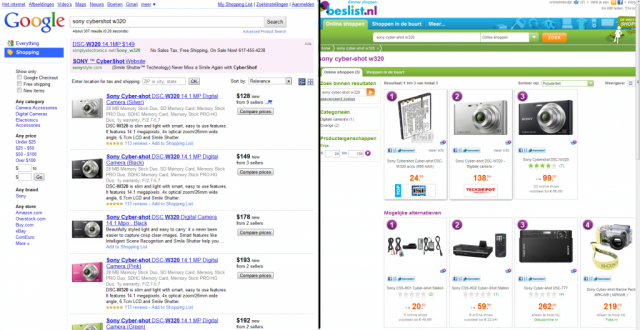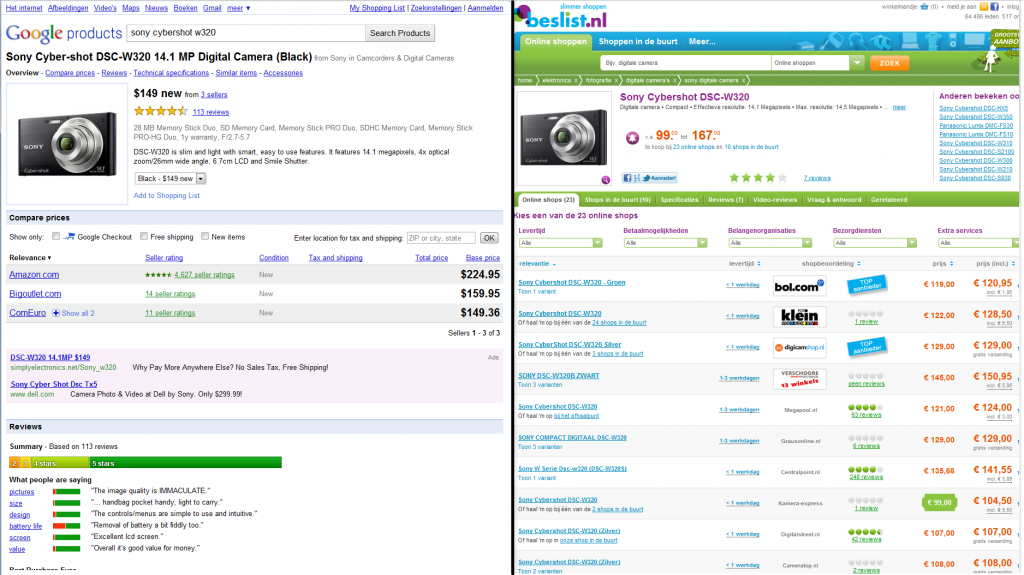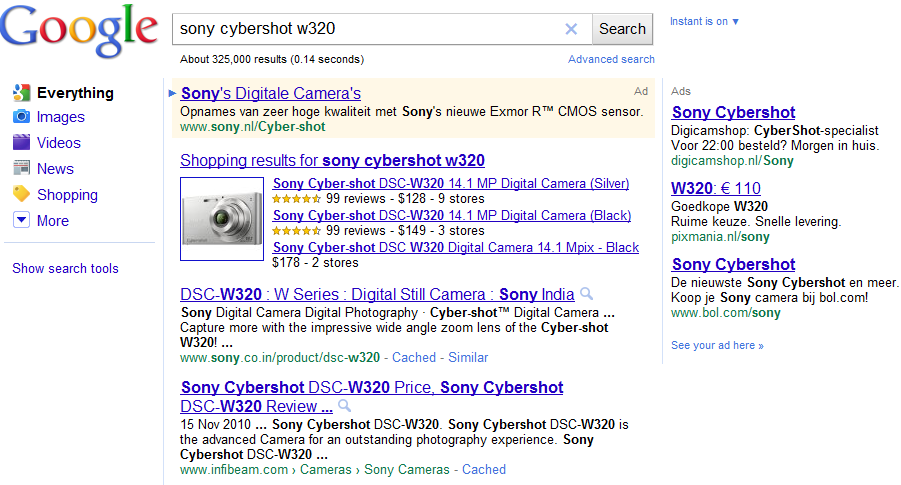In February Google officially announced that the Google Merchant Center will launch in Spain, Italy and the Netherlands. Google Shopping is the vertical search engine from Google where visitors, as you’ve already guessed, can search for products. As a company, you can take part by introducing and tracking your products using data feeds. And now, after a few months of preparation, it has finally arrived here in The Netherlands and you can check it here: Google Product Search Netherlands.
Google Product Search
In the United States and the United Kingdom, Google Shopping goes under the name of Google Product Search. As mentioned, Shopping is a vertical search engine for products. It is also a price comparison site like Beslist.nl or Kieskeurig.nl. A simple comparison shows that there is little difference between sites like these and Google Shopping:
Even the detailed product pages are very similar:
Personally, I think Google Shopping is even a bit nicer to look at. The use of more white space makes it easier on the eyes in my opinion.
Visitors can also look for products at Google Shopping and then look into which providers there are and compare prices. And here too, visitors can write reviews of the products.
An advantage for the consumer is that Google has given suggestions for certain products. This enables the user to search faster, but it can also provide the consumer with ideas for other alternative products.
Providing your product data
But how can you get your product data into Google? To do that, you will have to register with Google Merchant Center. Here you will have to add a product feed (data feed) which you will send to Google. The whole process is, as we may expect from Google, documented in their Help Center.
You can provide your product data in text-DSV format or in XML format. The guidelines for the feed specification can be read here:
The following components are required:
- International product code
- Title of the product
- Description (text description of the product)
- Condition (state of the product, such as “new”)
- Price of the product
- Link to your own website
- GTIN: (the barcode, often EAN code) – since the 3rd of May this is mandatory)
And strongly recommended are:
- Image link
- Brand
- MPN (part or model number of the manufacturer)
- Quantity
- Delivery information for the product
There are more product data you can pass on to Google, you can look them all up here.
Uploading the feed can be through a planned upload, FTP or manual upload.
Conditions for the Merchant Center
In the Google Shopping Conditions it states, among other things, that you have to ensure that all URLs to your website work and that they have to be direct URLs. The product availability must be indicated and if the product is no longer available, that must be stated, or you have to remove the product from the feed or set the quantity must to “0”. Furthermore, the products must have fixed prices and there are also conditions on the content which you present to the visitor.
Google Shopping in Organic Search Results
An advantage and a disadvantage of Google Shopping is that Google Shopping results can also be seen in the “organic” search results from Google. That is, when people “regularly” search in Google for a product, results from Google Shopping can also be returned (just as images and videos are returned in the search results). This can be an advantage for suppliers who otherwise wouldn’t appear on the first page. At the same time, this is a disadvantage for websites which were on the first page and now get a lower (visual) position because the product results push the regular results downwards.
Tough on affiliates
Affiliates are not permitted to use Google Shopping. Only companies who supply directly may forward their product feeds to Google.
Product Ad Listing for Google AdWords
Finally Bijgespijkerd noticed that eventually in the Netherlands it will also be possible to connect Google Shopping to Google AdWords, so that your products can also be shown in your AdWords advertisements. To do this, you can create text advertisements for your products or advertisements with images attached. This can be done by selecting the option “extend my ads with relevant product details from Google Merchant Center” in AdWords. Watch the video for more information on this:
Just like Sitelinks, the extension with your product listings provides could lead to a higher conversion rate. The advertisement is also shown when somebody looks for a specific product that you also have in your range.
Finally
Price comparison sites will not be happy about the arrival of Google Shopping and some companies which score well in the organic “search results” may be negatively affected by Google Shopping. Other companies may be given a further boost and the visibility of your products may be increased enormously. Time will tell, but price comparison is now getting easier and can even play a greater part in the online purchasing of products. Also, the competition may increase. Linking with AdWords may give advertisers a higher conversion rate, because the ads are even more attractive and provide for even better match with the users’ search query. The disadvantage could be that advertising via AdWords just got a little more complex.
To sum it up: Google Shopping may just shake things up in the online shopping landscape in the Netherlands. From a consumers’ perspective it seems that Goolge Shopping will prove to be a useful place for finding the best (or cheapest) place to order your product.








